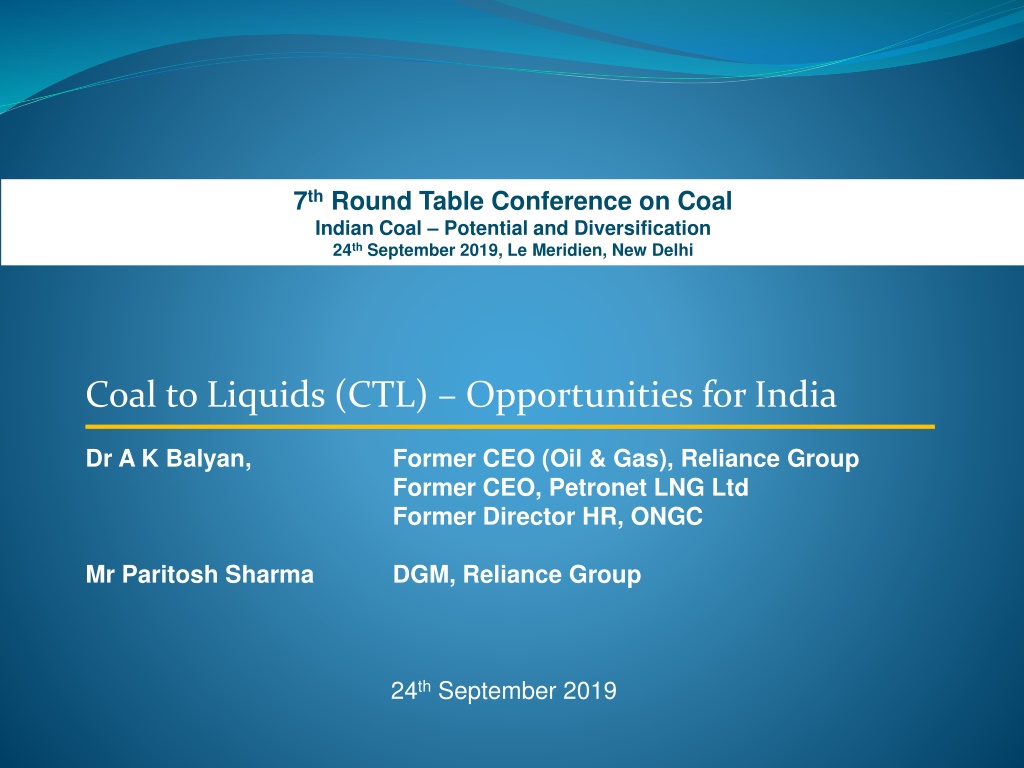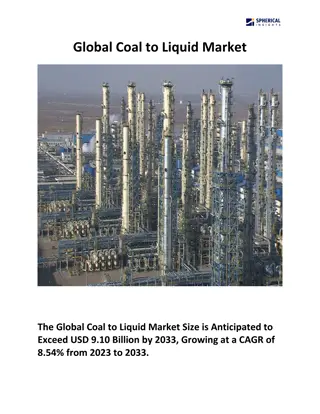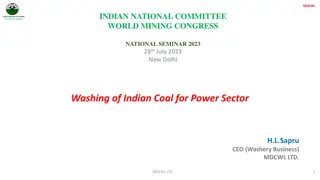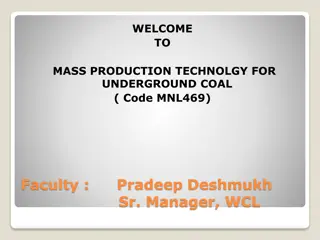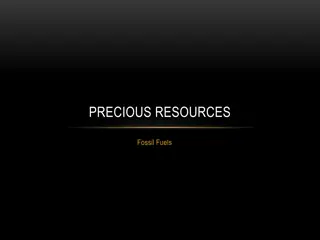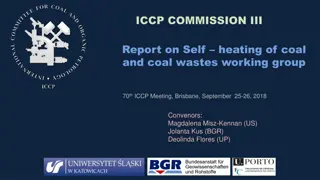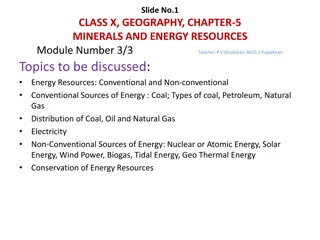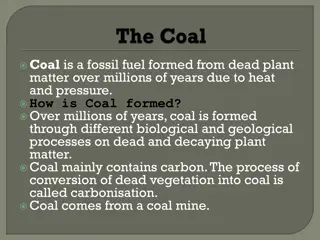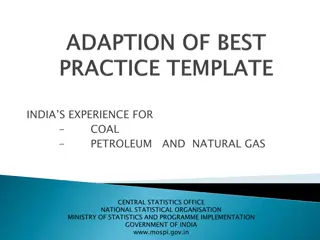Exploring Coal-to-Liquid Technology for Energy Security in India
India's abundant coal reserves present opportunities for utilizing Coal-to-Liquid (CTL) technology to convert coal into liquid hydrocarbons. The CTL process, proven and popular globally, offers a potential solution for energy security and reducing dependence on oil imports. Despite past challenges with coal gasification projects, recent initiatives show promise for implementing CTL technology in various sectors, including steel production and fertilizer plants. Embracing CTL and Coal Gasification technologies could enhance India's energy self-sufficiency and economic growth.
Download Presentation

Please find below an Image/Link to download the presentation.
The content on the website is provided AS IS for your information and personal use only. It may not be sold, licensed, or shared on other websites without obtaining consent from the author. Download presentation by click this link. If you encounter any issues during the download, it is possible that the publisher has removed the file from their server.
E N D
Presentation Transcript
7th Round Table Conference on Coal Indian Coal Potential and Diversification 24th September 2019, Le Meridien, New Delhi Coal to Liquids (CTL) Opportunities for India Dr A K Balyan, Former CEO (Oil & Gas), Reliance Group Former CEO, Petronet LNG Ltd Former Director HR, ONGC Mr Paritosh Sharma DGM, Reliance Group 24thSeptember 2019
Disclaimer : The views and opinion expressed in this presentation are those of the authors only.
Coal in India India has coal reserves of around 319 Bn Tonne Around 77% of this is low grade coal i.e. ~ 245 Bn Tonne India produced ~732 Mn Tonne of coal in 2018-19 & imported about 230 Mn Tonne Avg price of low grade coal with calorific value of ~4500 Kcal/Kg is Rs1200/MT Coal Comparison Indian Indonesian South Africa Australian Fixed Carbon % 31 - 38 20 - 21 43 - 58 35 - 52 Volatile Matter % 20 - 27 23 - 29 22 - 32 24 - 35 Ash % 24 - 36 4 - 7 11. - 30 < 15 Total Moisture % 12 - 18 40 - 50 2.6 - 4.8 < 16 GCV Kcal/Kg 3600 - 4800 2850 - 3730 5000 - 7400 5800 6400 Price Parity $/Mmbtu 1.00 2.72 4.58 4.34 Explore other options for value extraction Slide 3
Why Coal to Liquid (CTL) Coal-to-Liquid (CTL) technology converts coal to Liquid Hydrocarbons CTL process is technically & commercially proven and gaining popularity With escalating oil prices, lot of interest is being generated in CTL process Commercially started way back during WW-II in Germany and subsequently in USA owing to rising oil prices in early 1950s South Africa is producing significant amount of its oil requirement through CTL route since 1955. China is making massive investments in CTL on its concern about rising dependence on oil imports and its impact on economic growth & national security Most recently CTL concept has been changed to CTX where variety of hydrocarbons are produced from a carbon resource like coal India should not ignore CTX owing to abundance of domestic coal and for Energy security Slide 4
Coal Gasification in India FCIL had setup Fertilizer plants at Ramagundam, Sindri and Talcher during 1970-80 using coal gasification technology Failed to achieve commercial success GOI awarded coal blocks in Orissa to JSPL-Lurgi and Tata-SASOL JV in 2009 for setting up 80,000 bbl per day CTL plant each Both projects were scrapped due to various reasons including cancellation of the allocated coal blocks JSPL has setup a coal gasification project at Angul, Orissa for its DRI based Steel plant in 2013 RIL has setup a Petcoke-Coal blend to SNG project to replace its LNG import, and is about to ramp up to full capacity by FY2020. CIL, GAIL, RCF & FCIL formed JV Talcher Fertilizer Ltd to setup a new coal gasification based 1.27 MMTPA Urea Plant at Talcher. Both the Gasification and Ammonia-Urea blocks have been awarded to Wuhuan Engg Co Ltd, China on LSTK basis. Coal India Ltd has announced setting up a 0.6 MMTPA Coal to Methanol plant at Dankuni Coal Complex. NITI Aayog has setup a Technical Committee to promote suitable business model and suitable technology for the development of Surface Coal Gasification (SCG) in Indian conditions Slide 5
CTX - Technology Options Two different approaches exist for coal to liquids Direct Coal Liquefaction (DCL) No Gasification, direct conversion of coal to raw liquid hydrocarbon using H2, Catalyst & Solvents Less popular: Only one commercial plant in Shenhua, China Indirect Coal Liquefaction (ICL) Coal is Gasified to Syngas; Syngas is further processed with wide product options Highly popular: Almost all commercial plants across the world are based on ICL The three generic type of Gasifiers are Fixed/Moving Bed Gasifiers Fluidized Bed Gasifiers Entrained Flow Gasifiers Very robust and can handle all ranks of coal Not suitable with high ash coal (Indian coal) Can handle all ranks of coal In commercial operation at SASOL with high-ash coal Commercially proven with few references Commercially Proven Most popular among new projects Tech. Provider - Lurgi & Envirotherm (BGL) Tech. Provider - KBR, SES, Winkler etc Tech. Provider - GE, Shell, MHI, McDermott(Egas) Slide 6
Value Added Products from Coal Coal Power & Steam SNG Gasification F-T products Naptha Ammonia & Urea H2 Synthesis Gas Waxes Synthetic fuels Methanol Acetic Acid Methyl Acetate Ethylene & Propylene DME Acetate Esters Ketene Acetic Anhydride Oxo Chemicals Polyolefins Diketene & Derivatives Slide 7
Macro Economic Evaluation - 1 Among the vast product range, 3 main process routes of CTX viz. Methanol, FT- Liquids and Ammonia have been considered for economic evaluation 1 million tonne per annum capacity for each product considered for an equitable and easy comparison Plant Capacity Production Cost Product Indian Coal SYNGAS MM TPA Mn TPA mmscfd US $/MT Methanol 1 3.05 328 291 Urea 1 1.62 173 220 FT Liquid (Diesel) 1 8.13 873 603 Basic assumptions considered for the evaluation Typical Indian Coal CV Typical Indian Coal Cost Gasification Technology Power Neutral Gasifier Efficiency : : : : 3800 950 SES U-Gas Fluidized BedGasifier 75.9 % Kcal/Kg Rs/Kg Slide 8
Macro Economic Evaluation - 2 Comparison with Conventionally Produced Products - Deduced CTL route production costs are loaded with 1.5% to account for the storage and freight CTL Route Production Cost Freight 1.5% $/MT S/MT Methanol 291 4.37 Urea 220 3.31 FT Liquid (Diesel) 603 9.05 Assumed Storage & CTL Route Deduced Prod. Cost Net of Taxes $/MT 296 224 613 Conventional Production Cost* Net of Taxes Product $/MT 372 251 654 High upfront investment in processes like Coal to Urea as compared to conventional Involvement of Coal requires additional handling and safe disposal of ash and coal fines Coal to Liquid process requires huge water requirement ~ 8-10 tons per ton of liquids Elemental Sulfur / Sulfuric Acid is produced as by-products - gives additional cost advantage. Our case plants can produce ~ 100 TPD sufuric acid which can give upsides to the tune of Usd 4.6 Mn per Annum at a price of US$ 140/MT Production costs are in comparable range * Source: PPAC, NUP 2015, Methanex Slide 9
Investment Costs Step-1: Coal to Syngas Plant Capacity Investment Syngas Cost Debt : Equity Cost of Debt Cost of Equity : : : : : : 6.0 mmscmd NG Equivalent 2266 Mn USD 7.42 USD/mmbtu 70 : 30 10% 14% Step-2: Syngas to Product Plant: Investment Cost for 1 MMTPA Capacity Syngas Produced Investment Coal to Syngas Investment Syngas to Product Total Plant Investment Coal to mmscfd Mn USD Mn USD Mn USD 328 1031 163 1194 Methanol 173 545 411 956 Urea 873 2743 567 3310 FT Diesel Slide 10
Way Forward India must consider development of Coal Based Hydrocarbon Fuels in view of: Utilization of large inferior coal reserves which are otherwise not targeted for usual commercial use Promote Clean Coal Technology Enhance Country s Energy Security by developing CTX as a replicable alternate technology Government to promote CTX through national projects based on PPP model high investment requirements technology import requirements faster implementation Government to incentivize Coal Gasification based projects through policy changes like lower taxation, obligatory use and soft funding Government to facilitate by identifying coal mines and obtaining all necessary clearances/approvals for project developers Slide 11
